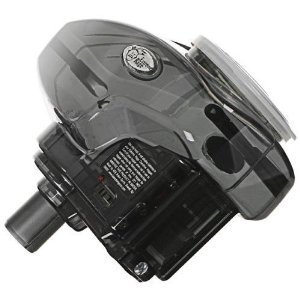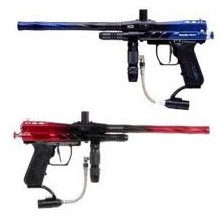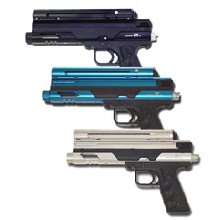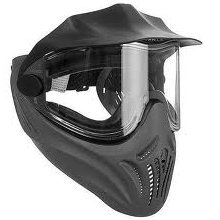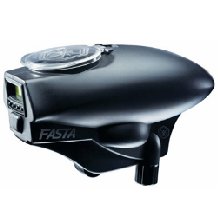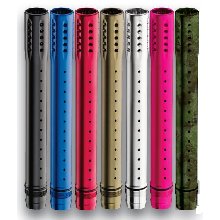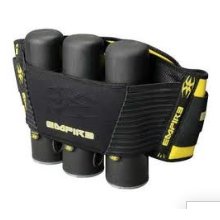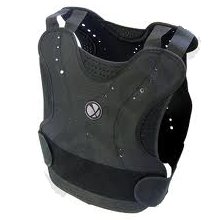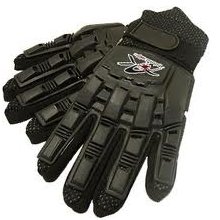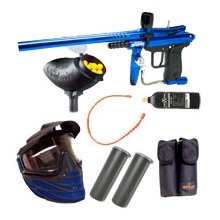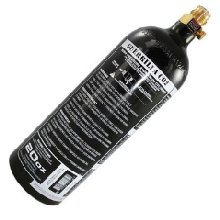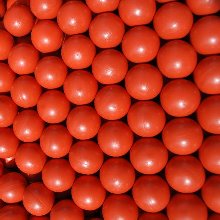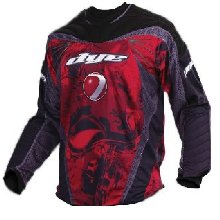Paintball Hoppers
Unlike a standard gun, where the ammo is fed upward from beneath, paintball markers receive their ammuntion from above. The container on the top of your gun where the paintballs are loaded into is called the hopper.
Unfortunately, hoppers are the most cumbersome part of your paintball gun. They usually contain a 200+ ball capacity, and they can make your gun top-heavy. When you begin a paintball game your hopper should always be filled.
Because today's markers shoot so fast, you can go through ammo very quickly. You might need to reload once or even twice during a long paintball game, depending upon how conservative you are with your shots (and how quickly you get eliminated).
The hopper feeds balls into the firing chamber one at a time, relying on gravity to pull the next ball downward after each shot. Sometimes this isn't fast enough, especially in keeping up with a very fast paintball gun. This leads to misfires, such as the gun firing without a ball in the chamber.
Other times two balls fall simultaneously, getting stuck against each other so that no further balls can enter the weapon.
Misfires are bad, but they can be made even worse when the gun fires before a ball is fully loaded. This leads to "chopped" paintballs, and once a ball breaks inside your gun your weapon will never fire straight again until it's thoroughly cleaned.
Luckily, technology can help you out. Going beyond the standard no-frills model, you can buy paintball hoppers with a built-in motor and turnstyle system. Most of these hoppers use a laser to determine if there's a ball ready to drop into the gun. If not, the turnstyle is engaged and balls are automatically fed as the motor rotates balls into position.
The hoppers shown above range from unmotorized vanilla models all the way to battery-powered auto-loaders that have sleek, stylish designs. Some of them come in multiple colors or camo effects.
Since the hopper makes up such a big part of your gun, many players with high-end paintball markers want a good-looking hopper. And can you really blame them?
Choosing a Hopper For Your Paintball Gun
Picking the right hopper isn't so much about preference as it is about the type of paintball marker you'll be using with it. You don't want a high-end gun with a low-end hopper.
For a rental Tippmann, the standard plastic 'premium' hopper (which is probably the furthest thing from premium) will do just fine. But when you're firing a fully tricked out Planet Eclipse marker with aftermarket everything? You'll need a high-powered ball hopper to keep up with such a potentially rapid rate of fire.
Believe it or not, pro-level feed rates can require 50 or more balls per second. In that case look for a constant-feed rotor carousel, which means the hopper motor is always rotating from the moment you flip the switch until you finally turn it off.
Transparent Paintball Hoppers by ViewLoader
Viewloader pioneered hoppers that were semi-opaque or even transparent, so players could see how many balls were left inside; a huge advantage for knowing when to reload.
This was especially important for the elbow joint: the piece that actually attaches the hopper to the paintball gun, as shown below.
Transparent elbows allow you to see ball jams, and also when there's paint getting thrown around in your gun from a chopped or broken ball.
Feed elbows come vertical (up and down) or molded at a 45-degree angle. This enables you to seat the hopper directly on top of your gun or slightly off to the side.
Some players like to look down the top of their gun while aiming, or even mount a scope on the upper rail of their paintball markers. In this case a 45 elbow would keep the hopper out of the line of sight.
Aluminum elbows also exist with "teeth" that grip the paintball hopper more tightly, which keeps it from rotating side to side. You never want your hopper turning or rotating during a game of paintball if you can avoid it. A rotating hopper makes the weapon awkward to fire, and it makes your hopper a lot easier of a target to hit. If you don't get one with teeth, at least make sure you tighten the screws.
Other Paintball Equipment, Markers, and Protective Gear
Choose from the following categories of paintball gear. From paintball protective wear to aftermarket barrels and accessories, you'll find choices for the professional and beginner player alike.
